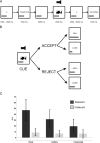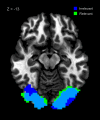Reward-related activity in ventral striatum is action contingent and modulated by behavioral relevance
- PMID: 24453318
- PMCID: PMC3898287
- DOI: 10.1523/JNEUROSCI.4389-13.2014
Reward-related activity in ventral striatum is action contingent and modulated by behavioral relevance
Abstract
Multiple features of the environment are often imbued with motivational significance, and the relative importance of these can change across contexts. The ability to flexibly adjust evaluative processes so that currently important features of the environment alone drive behavior is critical to adaptive routines. We know relatively little about the neural mechanisms involved, including whether motivationally significant features are obligatorily evaluated or whether current relevance gates access to value-sensitive regions. We addressed these questions using functional magnetic resonance imaging data and a task design where human subjects had to choose whether to accept or reject an offer indicated by visual and auditory stimuli. By manipulating, on a trial-by-trial basis, which stimulus determined the value of the offer, we show choice activity in the ventral striatum solely reflects the value of the currently relevant stimulus, consistent with a model wherein behavioral relevance modulates the impact of sensory stimuli on value processing. Choice outcome signals in this same region covaried positively with wins on accept trials, and negatively with wins on reject trials, consistent with striatal activity at feedback reflecting correctness of response rather than reward processing per se. We conclude that ventral striatum activity during decision making is dynamically modulated by behavioral context, indexed here by task relevance and action selection.
Keywords: action value; multisensory; policy selection; reward; ventral striatum.
Figures




Similar articles
-
Effect of relevance on amygdala activation and association with the ventral striatum.Neuroimage. 2012 Aug 1;62(1):95-101. doi: 10.1016/j.neuroimage.2012.04.035. Epub 2012 Apr 23. Neuroimage. 2012. PMID: 22546319
-
The rewarding value of good motor performance in the context of monetary incentives.Neuropsychologia. 2012 Jul;50(8):1739-47. doi: 10.1016/j.neuropsychologia.2012.03.030. Epub 2012 May 6. Neuropsychologia. 2012. PMID: 22569215
-
Brain networks of social action-outcome contingency: The role of the ventral striatum in integrating signals from the sensory cortex and medial prefrontal cortex.Neurosci Res. 2017 Oct;123:43-54. doi: 10.1016/j.neures.2017.04.015. Epub 2017 May 3. Neurosci Res. 2017. PMID: 28477977
-
Limbic-striatal interactions in reward-related processes.Neurosci Biobehav Rev. 1989 Summer-Fall;13(2-3):155-62. doi: 10.1016/s0149-7634(89)80025-9. Neurosci Biobehav Rev. 1989. PMID: 2682402 Review.
-
Involvement of basal ganglia and orbitofrontal cortex in goal-directed behavior.Prog Brain Res. 2000;126:193-215. doi: 10.1016/S0079-6123(00)26015-9. Prog Brain Res. 2000. PMID: 11105648 Review.
Cited by
-
Modeling subjective relevance in schizophrenia and its relation to aberrant salience.PLoS Comput Biol. 2018 Aug 10;14(8):e1006319. doi: 10.1371/journal.pcbi.1006319. eCollection 2018 Aug. PLoS Comput Biol. 2018. PMID: 30096179 Free PMC article.
-
Success and failure of controlling the real-time functional magnetic resonance imaging neurofeedback signal are reflected in the striatum.Brain Behav. 2019 Mar;9(3):e01240. doi: 10.1002/brb3.1240. Epub 2019 Feb 20. Brain Behav. 2019. PMID: 30790474 Free PMC article.
-
No Effect of Commercial Cognitive Training on Brain Activity, Choice Behavior, or Cognitive Performance.J Neurosci. 2017 Aug 2;37(31):7390-7402. doi: 10.1523/JNEUROSCI.2832-16.2017. Epub 2017 Jul 10. J Neurosci. 2017. PMID: 28694338 Free PMC article.
-
Associations between resting-state neural connectivity and positive affect in social anxiety disorder.Brain Behav. 2023 Jun;13(6):e3006. doi: 10.1002/brb3.3006. Epub 2023 Apr 16. Brain Behav. 2023. PMID: 37062915 Free PMC article.
-
Dopaminergic basis for signaling belief updates, but not surprise, and the link to paranoia.Proc Natl Acad Sci U S A. 2018 Oct 23;115(43):E10167-E10176. doi: 10.1073/pnas.1809298115. Epub 2018 Oct 8. Proc Natl Acad Sci U S A. 2018. PMID: 30297411 Free PMC article.
References
Publication types
MeSH terms
Grants and funding
LinkOut - more resources
Full Text Sources
Other Literature Sources
